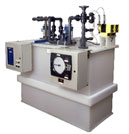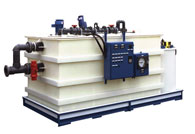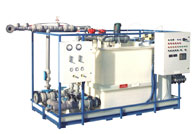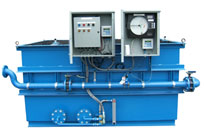Sulfuric Acid Neutralization
Sulfuric acid is the most commonly produced chemical in all of industry (according to the USGS) with uses in fertilizer production, chemical production, as a drying agent, as battery acid and much more. It is a strong diprotic acid with as little as one drop of acid required to decrease the pH of one liter of water from 7.0 to less than 3.0. Consequently it is one of the most common sources of acidity that must be neutralized before discharge.
Sulfuric Acid H2SO4
Sulfuric Acid H2SO4: The most widely used and produced chemical in the world. Available in concentrations ranging from
10% to 98% sulfuric is
also the least expensive acid to use as a neutralizing agent. Sulfuric acid is used almost universally for neutralization reactions. It is easier and safer to use than HCl or HNO3 and is more potent than all of the other acids except for phosphoric. Although adverse reactions are always a possibility, they are rare.
If calcium is present then calcium sulfate (CaSO4), also known as gypsum, will precipitate. Unless calcium is abundantly present this is not an issue.
Sulfuric acid is typically used in concentrations ranging from 25% to 96%.
Sulfuric acid is a two normal solution which means that for each mole of sulfuric two moles of H+ or acid are liberated packing twice the punch than
an equivalent molar concentration of hydrochloric acid, for example.
One mole of sulfuric acid will neutralize two moles of sodium hydroxide, as follows:
2NaOH + H2SO4 → Na2SO4 + 2H20
Conversely one mole of sulfuric acid will neutralize one mole of Ca(OH)2 (lime) as lime is also two normal:
Ca(OH)2 + H2SO4 → CaSO4 + 2H20
Heat of Neutralization
All pH neutralization reactions are exothermic and heat will be released. In most practical applications the acid concentration is too low for the temperature rise to be a concern, however, as the concentration of acid increases above about 1% the temperature rise is not only measureable but can be of concern.
ΔHN = 55.83 KJ / Mole of H+
For example, neutralizing a 10% solution of sulfuric acid will yield a temperature rise of nearly 300C while neutralizing a 93% solution of concentrated sulfuric will yield a temperature rise of over 1500C. This is enough to meltdown any thermoplastic piping system and hot enough to cause steam explosions.
Our concentrated acid pH neutralization systems take into account the known temperature rise and measures are taken to control this by continuous temperature monitoring, reaction rate control and, when required, the addition of quench water. An example of a concentrated acid pH neutralization system can be seen at: Battery Acid Neutralization
Precipitation Products
The pH neutralization of any strong acid with a strong base will produce a salt. When one of the reactants is relatively dilute the products of
neutralization will remain soluble, particularly if sodium (Na) is the cation. However, if the cation is calcium (Ca) or if the concentration of both reactants is
elevated then precipitation products (insoluble salts) will begin to form. In some cases these can simply be discharged to the drain, in others they may need to be removed
for any number of reasons. whenever precipitation products are formed they can also become a maintenance headache.
In the example given above where sulfuric acid is neutralized using lime the byproduct will be CaSO4 which is also know as gypsum. Gypsum is a white sludge that will adhere to
tank walls, pipes, pH probes, and anything else in its path.
Digital Analysis Corp. manufacturers a complete line of pH neutralization systems for the neutralization of sulfuric acid and all mineral acids, bases, organic acids, and alkalis.
A very common source of sulfuric acid in our environment comes from
lead-acid cell batteries such as car batteries. We also manufacture
a complete line of battery acid pH neutralization systems:
Battery Acid
Neutralization and pH
Adjustment Systems.
Packaged / Skid Mounted pH Neutralization Systems
Digital Analysis manufactures four families of pH adjustment
systems.
These include: pHASE, labTREAT, batchTREAT, and hydroTREAT

pHASE Family of pH Adjustment systems are batch systems designed to handle continuous flows from 0-60 GPM. The pHASE family is capable of handling a variety of wastewater influent streams ranging from highly acidic to highly alkaline.
- Continuous flows from 0-60GPM
- Compact platform
- Bi-directional: neutralize acids and bases.
- Batch system design.
- Will handle concentrated acids and bases.
- Completely Automated

labTREAT Family of pH Adjustment systems are continuous flow through systems designed to handle continuous flows from 0-300 GPM. The labTREAT family is capable of handling a variety of wastewater streams from industrial and institutional research laboratories.
- Continuous flows from 0-300GPM
- Available in one, two, and three stage designs.
- CIP neutralization - well suited for hot CIP wastes.
- Bi-directional: neutralize acids and bases.
- Continuous flow through system design.
- Will handle high flows in a minimal footprint.
- Completely Automated

batchTREAT Family of pH Neutralization systems are designed to handle continuous flows of industrial wastewater from 0-10,000 GPM. This large platform system is a batch system that handles continuous flows that can be highly acidic or highly alkaline.
- Continuous flows from 0-1,000GPM
- Many options including duplex / redundant pH system design.
- Bi-directional: neutralize acids and bases.
- Batch system design.
- Will handle concentrated acids and bases.
- Completely Automated

hydroTREAT Family of pH Neutralization systems are specifically designed for alkaline / high pH influent flows, particularly wastewater from concrete and hydrodemolition applications. The hydroTREAT family is designed to use carbon dioxide (CO2).
- Continuous flows from 0-1,000GPM
- Concrete wastewater - Designed specifically for concrete wastes, hydro-demolition wastewater, and tunneling wastewater and runoff.
- Does not require the use of hazardous chemicals such as concentrated acids.
- Safe carbon-dioxide (CO2) usage.
- Designed for outdoor use on unimproved surfaces.
- Completely Automated
